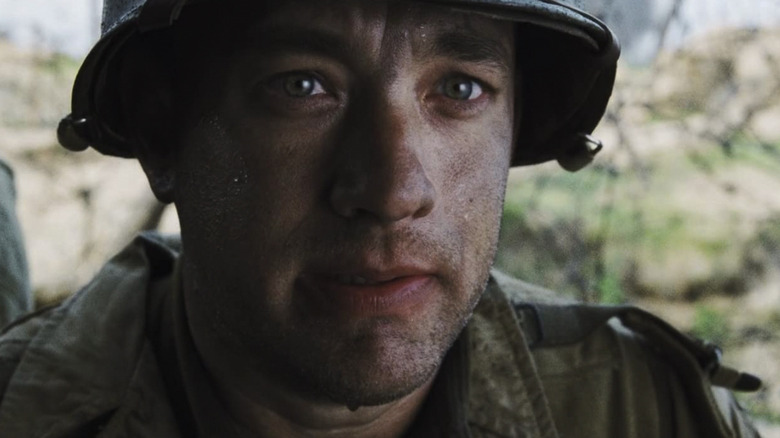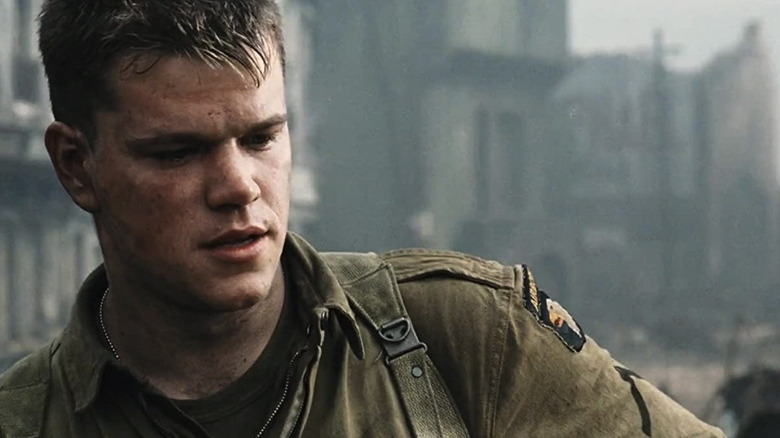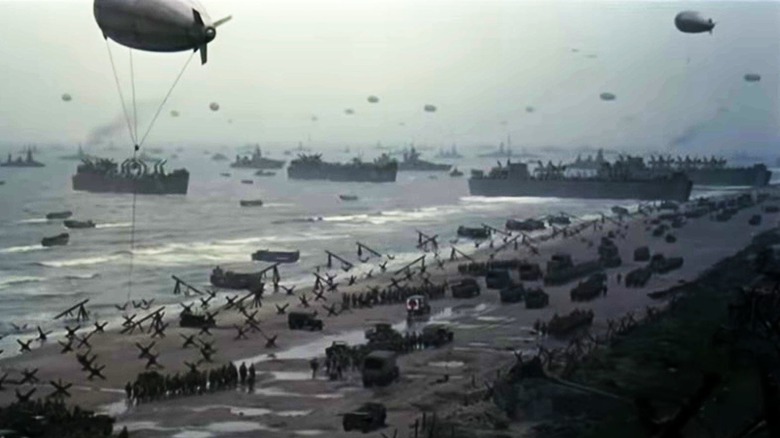The Original Inspiration Behind Saving Private Ryan Didn't Actually Come From WWII
"Saving Private Ryan" holds a special place in the pantheon of WWII movies. Known for its bloody realism and Janusz Kaminski's Academy Award-winning cinematography inspired by photojournalist Robert Capa's pictures of the D-Day landing, the film shaped the public imagination of the war for generations. Audiences now know it as the quintessential WWII film, but screenwriter Robert Rodat found its inspiration in an entirely different era.
In the movie, three of four brothers in the Ryan family have already perished in action. U.S. Army Chief of Staff George C. Marshall (Harve Presnell) has determined that for the sake of morale, they can't afford to lose the remaining son. So begins the grim and daunting task of eight army soldiers led by Captain John Miller (Tom Hanks), who must find Private James Francis Ryan (Matt Damon) and bring him home.
After meeting with producer Mark Gordon, Rodat discovered his idea for the WWII epic in the annals of a different historical period. As an Entertainment Weekly article explains:
"In a New Hampshire village called Putney Corners, there's a monument to men who died in conflicts from the American Revolution to the Vietnam War. The 39-year-old Rodat, known mostly for the kiddie flick 'Fly Away Home,' noticed that eight members of the same family had perished in the Civil War. After a little research, he changed the time frame to WWII and hunkered down to write a script — mostly fiction, although there's a real-life model in 'Band of Brothers.'
Though Rodat chose to set "Saving Private Ryan" against the backdrop of WWII, the driving force of the film comes from another callback to the Civil War in a reference to "The Bixby Letter." Considered by some as a better piece of writing than the Gettysburg Address, President Abraham Lincoln's condolence letter to the mother of the five Bixby brothers who died in battle is read aloud in the film by Marshall. It serves as both Marshall's call to action and the basis for a timeless tale of families ripped apart by war.
An intimate perspective
Historical details like those are what sets Rodat's screenplays apart from other war biopics. Rather than depict the horrors of war through sweeping, epic battle scenes, Rodat told The New York Daily News that he preferred to take a more personal approach to his historical fiction:
"What interests me right now is big-canvas stories told from an intimate perspective ... I like to find one small story within the larger picture and use that — not as a microcosm, but as an illustration. I don't claim that Benjamin Martin, my main character in 'The Patriot,' says everything there is to say about the American Revolution. But the goal is to have one small, emotional and dramatic story about a complex character — with a matrix of people around him [who can transport] the audience to a different world and time."
Whether it's the rescue of the sole surviving brother in "Saving Private Ryan" or one father avenging his family in "The Patriot," Rodat chooses to focus on one small story to bring pathos to macro, historical events. In a sense, he's taking a lesson from the success of Lincoln's Bixby letter, a story about one family that made a greater impact on Americans' understanding of the Civil War than thick tomes chronicling the minutiae of battle.
A moral education
The characters that emerge from Rodat's work are not so much exact replicas of real people from that time, but a melange of historical figures and notions from his own imagination. That mix of truth and fiction is both a recipe for success at the box office and a surefire way to annoy historians. In an interview with The Chicago Tribune, Rodat expressed frustration over some critics' tendency to put a period film up against the historical record. Comparing his take on the Benjamin Martin character in "The Patriot" to the work of Parson Weems, the 19th-century American historian who concocted the famous George Washington cherry tree tale, Rodat argued that the purpose of historical writing wasn't as cut and dry as it seemed.
"Weems saw history as having two functions. For him, it was establishing the historical record — and he played fast and loose with it — and to offer moral education."
It's possible that pop culture-obsessed Americans will remember more about the fictional characters in Rodat's work than the true, historical record. I can recall watching "The Patriot" in my fourth-grade history class and later being unable to recall the names of actual generals on a test, instead writing down the names of the actors. Even Hanks joked with Conan O'Brien that in his dotage, he will believe that he fought in WWII given his work in Rodat's film and other WWII-related material with which he's been involved. The takeaway is that Rodat's movies aren't meant to be history lessons. No matter what inspired "Saving Private Ryan," the toll of war remains the same.


